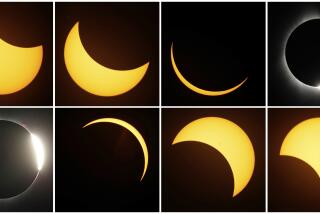Astronomy and the Imagination: A NEW APPROACH TO MAN’S EXPERIENCE OF THE STARS : by Norman Davidson (Methuen/Routledge & Kegan Paul: $15.95; 237 pp., illustrated) : The Soul of the Night: AN ASTRONOMICAL PILGRIMAGE by Chet Raymo (Prentice-Hall: $15.95; 209 pp., illustrated)
- Share via
The offhand curiosity that most people feel for matters scientific focuses powerfully for some into a life’s pursuit, or perhaps compulsion.
Chet Raymo and Norman Davidson have written highly personal books which are individual expressions of each author’s love of astronomy.
Davidson is concerned that the results of modern astronomy will be unintelligible to the public because so much of what is done in present research uses concepts of the sky that are abstractions of what is seen. It is his avowed purpose to provide an exposition of the relationships between astronomical concepts of solar systems phenomena and what is actually seen. The development of modern concepts has taken a long time, and Davidson ranges widely for his sources, drawing from Ptolemy and Einstein, from Palomar and ancient Egypt, from times and places between. His book hitches the Earth to the skies, using history and geometry as the traces. It is a book of logic, not poetry.
Raymo’s writing, by contrast, is far from the detached, unemotional objectivity of the stereotypical scientist. His words flow in response to the beauty he sees in the skies, in the results of research on these phenomena, and in the connections of these with facets of life around him. For Raymo, it is the synthesis of perception and conception that is important. When he describes the Milky Way, the concepts culminating all the galactic structure research of the century are sprinkled on six pages (with implied concern that the reader not be hindered by the myriad steps which led to those results). Both the phenomena and their explanations have beauty for the mind’s eye, for which Raymo also pens his personal, often lyrical responses.
Raymo is a professor of physics and astronomy at a small, distinguished liberal arts college in New England. This is one of the few environments where an academic who persists in finding the skies at night breathtaking can still survive professionally, to study, to teach and to craft his sensitive essays.
Davidson, too, is a teacher. History, literature, astronomy and geometry are among his subjects. The geometer is seen in the precisely drawn line diagrams that fill his pages. Raymo’s book has none of these. Instead, each essay is preceded by a wood engraving by Michael McCurdy.
Perhaps as good a way to contrast the authors’ viewpoints is to quote from their respective chapters on comets. Though both pay much heed to comet Halley, it is in their summaries of comet Kohoutek that their differences may best be caught. Davidson writes, “Although it turned out disappointing visually, Comet Kohoutek created considerable worldwide interest in 1974 and stimulated the imagination concerning comets and astronomy in general.” For Raymo, “Kohoutek’s visitation was a thing of hints and traits. The paperback publishers and cruise ship entrepreneurs were disappointed, but Kohoutek was a perfect comet, and like all perfect and beautiful things, was known not as we wished it to be but as it is.”
I will revisit both these books. Davidson’s, when I want to check some facts, and Raymo’s, whenever I want to feel again the breathless beauty of the night.
More to Read
Sign up for our Book Club newsletter
Get the latest news, events and more from the Los Angeles Times Book Club, and help us get L.A. reading and talking.
You may occasionally receive promotional content from the Los Angeles Times.







